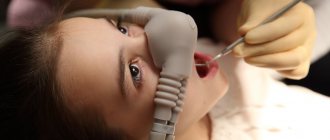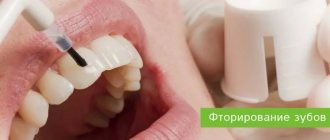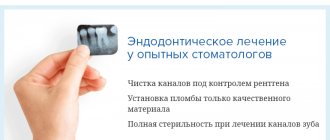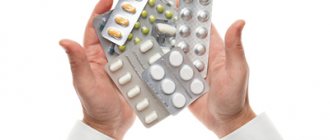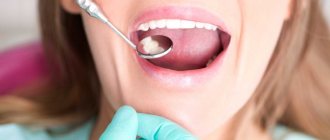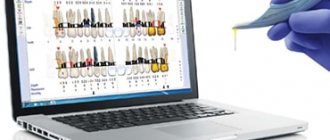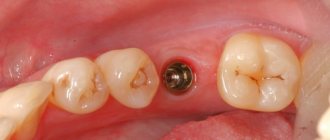Small concentrations of nitrous oxide cause a feeling of intoxication (hence the name “laughing gas”) and slight drowsiness. Nitrous oxide does not cause respiratory irritation. Nitrous oxide dissolved in blood plasma practically does not change, is not metabolized and does not bind to hemoglobin. After inhalation ceases, it is excreted (within 10-15 minutes) through the respiratory tract unchanged.
Inhalation of nitrous oxide with oxygen occurs using a comfortable mask, a pleasant aroma and a feeling of relaxation are felt. This procedure is completely safe, since nitrous oxide does not cause side effects or addiction, allergic reactions, is quickly and easily removed from the body, and has no aftereffects. This technology is used in both pediatric and adult dentistry. Nitrous oxide has been used in countries with progressive dentistry for more than 30 years. In the USA, Israel, and Great Britain, almost 100% of pediatric dental clinics use this technique on a daily basis. Therefore, it cannot be called new, but rather proven.
Technology of nitrogen-oxygen sedation
In the first moments of the procedure, the patient receives 100% oxygen, to which nitrous oxide is gradually added. Typically, the patient needs an optimal gas ratio of 70% oxygen and 30% nitrous oxide, however, sometimes this ratio can change depending on the individual characteristics of the body. Upon completion of sedation, the concentration of nitrous oxide gradually decreases, and oxygen correspondingly increases to 100%. Nitrous oxide is eliminated within 5-10 minutes of inhaling pure oxygen. Nitrous oxide-oxygen sedation provides the patient not only with calm and relaxation, but also with a significant reduction in pain and suppression of the gag reflex.
Can anesthesia be replaced with sedation?
The fundamental difference is that in the first case the person is conscious, while in the second he is not.
Treatment during sleep at the Atribeaute Kids clinic is carried out using the safe drug “Sevoran”. During the procedure, the child sleeps soundly under the supervision of the anesthesiology team.
With oxygen sedation, the patient relaxes, the level of stress decreases, but he is conscious, maintains contact with the doctor and assistant, and all reflexes are completely preserved.
The choice of treatment method and sedation is always determined by the doctor based on diagnosis, indications and contraindications.
A few recommendations before using nitrous oxide-oxygen
If you or your child is undergoing sedation, you must:
- firstly, you need to limit your food intake before the visit (a light snack is enough), because a full stomach can cause dizziness or mild nausea;
- secondly, the dentist should be warned about respiratory diseases, if any, as they may interfere with the achievement of the effect of sedation.
The doctors of our clinic will carefully and professionally perform sedation using nitrous oxide-oxygen so that visiting the dentist will be a pleasant and desirable procedure for you!
Nitrous oxide sedation: new views on an effective method
A mixture of nitrous oxide and oxygen (N2O/O2) is completely safe and has been successfully used for over 160 years to relieve pain and anxiety. In the early 1800s, dentist Horace Wells dedicated his life to promoting nitrous oxide in both general medical and dental practice. Because he promoted the use of nitrous oxide for pain control, he was posthumously given the title of "Discoverer of Anesthesia." Since that time, the method of sedation with nitrous oxide has become one of the most common in dental practice, in addition, it began to be used as a premedication at the beginning of the general anesthesia procedure.
Very often, dental patients seek help already with certain signs of pain or anxiety. Moreover, the feeling of anxiety can be associated directly with the visit to the dentist itself. Consequently, the doctor has to relieve these two sensations at once, since they are interrelated. The use of a mixture of nitrous oxide and oxygen at minimal cost allows you to effectively and safely deal with emotionally difficult clinical situations in dental practice. In this article, we will describe the main characteristics of nitrous oxide, indications for the use of the N2O / O2 mixture, and also analyze the main facts and myths associated with the long-term effects of nitrous oxide on the body, the biological effects of this gas, and approaches to minimizing the risk of contamination of the dental office space through N2O.
Advantages
Nitrous oxide/oxygen (N2O/O2) sedation offers a number of advantages over other sedation methods or alternative pharmacological agents. The properties of nitrous oxide allow this gas to not only relieve pain, but at the same time reduce anxiety. However, this effect is limited and observed over a short period of time. Nitrogen sedation can also be used in the treatment of patients with bronchial asthma, in which case the role of the gas is limited to the fact that it allows minimizing the effect of provoking stress factors. Nitrous oxide can be titrated, meaning that additional doses can be given to the patient over time until the desired level of sedation is achieved. Gas is eliminated from the body at almost the same rate as its accumulation. Most of the injected gas is eliminated through the lungs within a few minutes after stopping its supply and starting to breathe pure oxygen. You can also help remove nitrous oxide from the body by breathing regular air, but this manipulation will take a little longer. N2O/O2 mixture can be safely used among patients of all age groups. In addition to its main actions, it also allows you to somewhat suppress the gag reflex, thus creating conditions for conducting x-ray examinations and taking impressions. There are only a few contraindications to the use of nitrous oxide in dental practice, since its effect on the human body in general is neutral rather than negative.
Contraindications
In some situations, the use of N2O/O2 sedation should be delayed or avoided. When planning to undergo sedation, you should always seek the advice of your physician. The following are conditions under which it is imperative that the patient consult with a physician prior to undergoing sedation, and if consultation is not possible, the procedure should be postponed until the conditions described below have been completely relieved.
The use of medications during the first trimester of pregnancy is not recommended, therefore, exposure to nitrous oxide should be avoided. It is recommended to carry out any dental interventions in the second trimester. Similarly, with complete safety, a mixture of nitrous oxide and oxygen can be used in the second and third trimester of pregnancy, but, of course, after consultation with your doctor.
An upper respiratory tract infection (such as sinusitis) often causes nasal congestion, which may prevent gas from entering the respiratory system. In such cases, it is better to start sedation after the underlying disease has resolved. The use of a N2O/O2 mixture in cases of emphysema and chronic bronchitis is problematic; in these disorders, the use of sedation is prohibited due to the impossibility of ensuring proper airway patency. If you have chronic obstructive pulmonary disease, the use of sedation is possible only after consulting your doctor. Given that nitrous oxide has expanding properties, its use is limited in cases of active cystic fibrosis. Likewise, it is not advisable to use nitrous oxide after ophthalmic surgery. Certain complications after sedation can develop in patients after repair of the eardrum. As a result of the gas expansion phenomenon, complications with nitrous oxide use are predicted to occur in patients with pneumothorax or constipation.
On the other hand, patients with such pathological conditions rarely seek dental care until treatment for the above-mentioned disorders is completed. Patients taking bleomycin sulfate as a drug to treat certain types of cancer have an increased risk of developing pulmonary fibrosis. This outcome is associated less with the influence of nitrous oxide than with the influence of oxygen itself (at a concentration of more than 30%). But such situations (using bleomycin and performing sedation at the same time) are rather exceptions. According to the literature, after performing pneumoencephalography, there is an increase in intracranial pressure due to the fact that nitrous oxide replaces nitrogen molecules. Therefore, after pneumoencephalography, nitrous oxide sedation should be postponed for at least a week. One should be extremely careful when using sedation for psychological illnesses, and exclude the possibility of performing this manipulation when the patient is under the influence of drugs. It is also undesirable to perform sedation among patients who do not fully understand the essence of the manipulation due to impaired consciousness (for example, with Alzheimer's disease), as well as among patients taking psychotropic drugs. But it should be remembered that in addition to nitrous oxide sedation, there are other options that can be used in the above situations.
Based on our experience, we also recommend avoiding nitrous oxide sedation in patients with whom you cannot communicate well due to a language barrier, as well as in patients who suffer from claustrophobia and who have difficulty putting on and maintaining a mask in position. It is extremely important that the physician performing sedation is familiar with all evidence-based information regarding aspects of the implementation of this manipulation.
Evidence-Based Research
An evidence base is a necessary component for the implementation of effective dental treatment. There are several reports in the literature of the effects of nitrous oxide as an occupational risk factor. Historically, nitrous oxide has been associated with many disorders, ranging from birth defects to neoplasmic lesions. However, recent research indicates that low concentrations of nitrous oxide, such as those reported in dental office settings, are completely safe for dentists to use. It is also necessary to note the effectiveness and safety of new types of devices used for nitrous oxide sedation procedures. Of the 800 dental publications discussing the effects of nitric oxide that were published before 1995, only about 25 met the required parameters for reliability and validity. Many of the above-mentioned studies were conducted using retrospective designs, which in themselves are not very statistically reliable unless all methodological criteria are adhered to to the required extent. The first study of nitrous oxide as an occupational risk factor was published in 1967: a Russian researcher pointed out reproductive problems that were noted among anesthesiologists working in direct contact with the gas. Similar publications were presented in the United States in the late 1970s and early 1980s. But since then, methods for storing, supplying, dosing and using nitrous oxide have improved significantly. Nowadays, all such systems for working with gases are also equipped with special units for intake and purification of the surrounding air from traces of nitrous oxide. In addition, completely new systems for supplying nitrous oxide as a sedative agent continue to appear on the market, which are conceptually different from older analogues.
In one influential study from 1985, Sweeney and colleagues used an extremely sensitive deoxyuridine inhibition technique to identify critical levels of nitrous oxide concentrations. So, based on the results obtained, the visible biological effect of nitrous oxide is observed only at a concentration of 1800 parts per million (ppm). To date, there has not been a single clinically confirmed case of negative biological effects of nitric oxide in dental working conditions at the low levels of gas that are observed in the air during and after the sedation procedure.
Biological effects
The most significant biological effect associated with nitrous oxide exposure is its ability to inactivate vitamin B12. This mechanism affects an enzyme called methionine synthetase. Methionine synthetase, in turn, is essential for DNA production. Impaired fetal development was found in animals that were exposed to 60% nitrous oxide 24 hours a day for 12 days. The negative chronic effect of nitrous oxide on human reproductive function was discovered only in the conditions of incorrectly conducted studies, the subjects of which were exposed to high concentrations of the gas in the complete absence of cleaning of work areas. As for DNA synthesis disorders, such a risk is associated only with women during pregnancy, or with women planning to become pregnant. However, it is best to know the exact levels of nitrous oxide in a room before doing any work in it. The toxic effect of nitric oxide on the human body is the subject of debate in modern scientific literature. Despite this, available data indicate that the gas is completely safe when used in limited therapeutic doses. Neurological symptoms associated with nitrous oxide include numbness, tingling, and in some cases paraesthesia of the extremities, clumsiness, slow gait, altered reflexes, and muscle weakness. It is logical that the severity of these disorders is associated with the duration and dose of exposure to nitrous oxide. Cases of nitric oxide overdose reported in the literature have involved exposure to the gas for several hours a day for two weeks straight. However, some people exposed to chronic nitrous oxide indicate resolution of symptoms after the gas stops, and some indicate their permanent nature.
Concentration control
The National Institute for Occupational Safety and Health (NIOSH) and the American Conference of Industrial Hygienists (ACGIH) have been instrumental in developing recommendations regarding threshold levels of nitric oxide during human work activities during an 8-hour workday. In 1977, these organizations established nitric oxide concentration limits for health care workers. It has been determined that in operating rooms and dental offices, nitrous oxide concentrations should not exceed 25 and 50 parts per million, respectively. These levels were established based on the results of preliminary studies by Bruce, Bach, and Arbit, as well as the characteristics of the equipment used. These critical concentration levels are still relevant today. The Occupational Safety and Health Administration (OSHA) is the organization that has the authority to enforce these recommended levels; however, because of controversy regarding their appropriateness, OSHA recognizes that it would be desirable to revalidate such concentration limits.
To address several pressing issues regarding nitrous oxide, a meeting was convened in October 1995 by the Council on Scientific Affairs of the American Dental Association. It brought together several stakeholders, including respected experts in the field, educators, manufacturers and government officials. It was concluded that the true recommended exposure limit for nitrous oxide cannot be clearly established. Sweeney et al proposed a concentration level of 400 ppm as a cutoff. In their opinion, this level is the most commonly achieved, and is much lower than the 1800 ppm level at which the biological effects of nitrous oxide were first recorded. Other countries have adopted the following nitrogen oxide exposure limits: from 25 ppm in France and Denmark to 100 ppm in Sweden and Germany.
Estimation of nitrous oxide concentration levels
To determine whether traces of nitrogen oxide are present in a room, levels must be objectively measured in parts per million. To do this, they use a device - an infrared spectrometer, which allows you to determine the concentration of not only nitrogen oxide, but also other gases in terms of parts per billion (ppb). Of course, there is no point in buying it purposefully, but you can rent it either directly from the manufacturer or at a local hospital. In addition, the spectrometer allows you to detect areas of gas leakage from containers containing it. Another approach to estimating nitric oxide concentrations is to determine the amount of nitric oxide a person is exposed to over a period of time. To do this, the measuring device is simply put on, like a dosimeter, and carried with you for several hours. Thus, the time-weighted average (TWA) of nitrous oxide absorption is determined by its amount in the collecting tank of the measuring device.
Minimizing the risk of contamination
It is extremely important to pay due attention to measures to reduce the risk of nitrous oxide contamination. Disposal of trace gases can be ensured before, during and after use for dental purposes. Leakage of small amounts of nitrous oxide can occur in the area of all equipment connections, regardless of the specific use of portable or stationary equipment. To avoid this, manufacturers recommend periodic monitoring of the equipment used. Each manufacturer provides the necessary information regarding the frequency with which control measurements should be carried out, on average twice a year. Using ordinary soap and water, you can easily identify problem areas in terms of gas leaks in the system you are using. In addition, it is extremely important to ensure the reliable functioning of systems for the extraction of gas residues that form outside the nasal tube during its supply.
It must also be remembered that nitrous oxide can enter the doctor’s body not only due to system problems, but also directly from the patient. To minimize this effect, it is extremely important to limit conversation with the patient during the manipulation, because the gas that he inhales easily exits through the oral cavity. In addition, it is necessary to ensure that the mask fits snugly, taking into account its proper size. Sometimes all that is required for a tight fit of the mask is simply to form the necessary bend in the conductive tube. Despite the fact that nitrous oxide is much heavier than air, and even when it spreads outside the mask and tube, it immediately “falls” to the floor, this gas is also extremely expansive in nature. In other words, it spreads very quickly and easily over the entire surface area. On the other hand, the partial pressure of nitrous oxide is 31 times that of air, increasing the chance of it entering the physician's airway before it reaches the floor surface in cases of leakage.
Recommendations for monitoring nitrous oxide impurities in workroom air
Below is a list of recommendations and preventive measures aimed at minimizing the level of nitrous oxide contamination in the dental office environment.
- It is necessary to first establish the baseline concentrations of nitrous oxide in the clinic and in the surrounding air using an infrared spectrophotometer.
- To assess personnel exposure to gas, it is recommended that time-weighted instruments be used.
- Every 2 years, send equipment to the manufacturer for routine maintenance and evaluation.
- Provide visual monitoring of the integrity of conductive tubes and reservoirs.
- Use the "soap suds" principle to check the tightness of connections for possible gas leaks. To do this, add a few drops of detergent to a small amount of water, and wipe the areas of connections, reservoirs and conductive pipes with this solution. If there are gas leaks, bubbles will form.
- Ensuring effective evacuation of gas traces.
- It is necessary to assess the effectiveness of room ventilation and air exchange. In certain cases, measures may be required to improve the existing ventilation system to reduce the level of gas residues in the indoor air. Some air conditioning systems do not provide air exchange at all, but operate on the principle of recirculating existing air.
- Provide full information support to operating personnel regarding the possible risks of complications associated with chronic exposure to nitrous oxide.
Summary
The sedative effect of nitrous oxide allows you to optimize the treatment process for patients with existing fear of dental interventions. The use of this gas is justified by a number of advantages and only a small number of disadvantages. Understanding the principles of reducing the effects of nitric oxide on clinical staff is also an important factor in its effective use. Dentists should be fully aware of the new facts and basic concepts of the use of laughing gas in their daily practice, while paying special attention to monitoring the concentration of this gas in the air of the working environment. If you would like to know more about local restrictions regarding critical values for nitrous oxide that are relevant for your country or region, we recommend that you contact the appropriate quality control authorities for the provision of dental and medical care for information.
Authors: Ann Brunick, RDH, MS Morris S. Clark, DDS, FACD
Indications for treatment under ZAX
One of the main advantages of nitrous oxide is its safety: the gas is eliminated from the body in the shortest possible time and in an unchanged state. To recover from the state of sedation, no special antidotes are required, which is very important when treating children’s teeth. After 10–15 minutes, the little patient returns to his normal life and does not feel any side effects. Dental treatment with nitrous oxide for children is carried out very often and has a number of indications.
- Fear of the dentist. Any treatment under sedation can reduce fear of the doctor. Few children are not nervous before the appointment, so sedation is an ideal procedure for relieving stress.
- Preschool age. At a very young age, the use of potent drugs and tranquilizers is prohibited or not recommended. In this regard, nitrous oxide is a better solution.
- Pronounced gag reflex. Laughing gas not only does not provoke, but even suppresses the gag reflex.
Experts recommend using nitrous oxide in dentistry for children for no more than 1 hour. During this time, a fairly large number of manipulations can be performed, including treating pulpitis or periodontitis. If longer or complex treatment is required, then it is better to split it into several stages.
Forbidden Air
Poe's cousin, George, also took part in the popularization of laughing gas when he came up with a way to liquefy it. Before that, nitrous oxide had to be carried in huge bags, it was expensive and inconvenient, especially compared to injectable analgesics - for example, morphine, which was already gaining popularity in the second half of the 19th century. Liquefied nitrous oxide took up much less space; bags were replaced by metal cylinders, which settled in dental offices for a long time. And from there they went to parties.
Nitrous oxide existed in this capacity throughout the 20th century. And if the circulation of medical nitrous oxide could still be somehow controlled, then the smaller cylinders that were used to whip cream in restaurants slipped away from this control. Therefore, it was not difficult to obtain laughing gas. In addition, it was inexpensive - for example, at an American rock festival in the 1970s, gas cost 25 cents per balloon.
The philosopher Bertrand Russell in the 15th chapter of “The History of Western Philosophy” recalls, with reference to William James (the same one with whom we began our story), the following anecdote about a certain lover of laughing gas: “Whenever he was under the influence of this gas, he knew the secret of the Universe, but when he came to his senses, he forgot it. Finally, by great effort, he succeeded in writing down this secret before the vision disappeared. Fully awake, he rushed to look at what he had written down. It was: “The smell of oil is everywhere.”
Apparently, Russell made a mistake with the source and slightly changed the quote - there is reason to believe that this is a reference to the experiments of the physician Oliver Holmes not with laughing gas, but with ether, which had nothing to do with the secret of the Universe, and for Holmes everything smelled not of oil, but turpentine. Nevertheless, it was Russell’s version that became widely known; Letov sang “eternity smells like oil,” and laughing gas, under the influence of which James studied Hegel, in addition to euphoria, can actually cause hallucinations.
Despite the ambiguity of its effects, laughing gas not only did not lose its audience - but, on the contrary, even increased it as competitors were criminalized. By the late 2000s, about 15 percent of teenagers in the United States had tried nitrous oxide at least once in their lives. And in its homeland, Great Britain, by 2016 it had become the eighth most popular drug. At least one in three people in the kingdom were personally acquainted with it - while less than a percentage of British adults took opioids. It is unknown how many consumers of laughing gas there are in Russia, although, judging by individual medical studies, they exist, and there are many of them.
There are more and more studies of the consequences of consuming laughing gas around the world - and we are learning more and more about the possible side effects, which, as it turns out, laughing gas also has. Inhalations themselves are usually harmless: the psychogenic effect of the gas wears off within five minutes, since it does not stay in the blood for long and exits back through the lungs. Although disorientation in space and possible hallucinations can, of course, lead to injuries - especially if the person is driving a car.
But “fun breaks” can also have long-term consequences. Nitrous oxide in large quantities oxidizes the cobalt in the vitamin B12 molecule and disables it. And B12, in turn, is involved in DNA synthesis. Therefore, chronic inhalations can lead to a decrease in the number of red and white blood cells in the blood. In addition, disturbances in vitamin metabolism lead to the accumulation of methylmalonic acid, which causes damage to the myelin sheaths in the spinal cord and, as a result, neurological disorders. They are often described by researchers from China: patients complain of weakness, instability of gait and goosebumps.
Amid growing demand for laughing gas, governments in several countries have decided to outlaw nitrous oxide. In 2016, the UK toughened penalties for the illegal production and sale of laughing gas (however, this again applies only to medical nitrous oxide, while “food grade” laughing gas remains readily available). Northern Ireland also passed such a law - in 2022, after the death of a fifteen-year-old teenager.
In Russia, since January 1, 2022, Federal Law No. 472-FZ “On limiting the circulation of nitrous oxide in the Russian Federation” has been in force. According to it, the production, manufacture, supply, storage, transportation and shipment of nitrous oxide for purposes other than medical, industrial or technical use are prohibited. In addition, the sale and marketing of such products is prohibited, and nitrous oxide itself is considered an “intoxicating substance.”
Reviews
Natadent Clinic
– one of the few
pediatric dentistry in Northwestern Administrative Okrug
that actively uses
nitrous
in dental treatment for children.
This practice is widespread in Europe, the USA and Israel, but in Russia there are still few such clinics (even in Moscow,
not everyone uses sedation).
By contacting us, you can be sure that your child’s teeth will be treated with high quality, and he will experience a minimum of discomfort and will henceforth want to be treated only with us. You can read the reviews to make sure that our little patients and their parents always leave us happy.
LEAVE FEEDBACK